Yield and Quality Performance of Japonica Rice Varieties Grown in the Late Season in a Double Rice Cropping System of China
Shan HUANG,Hu HE,Xiufu ZHANG,Weixing ZHANG,Xiaohua PAN*
1.Collaborative Innovation Center for the Modernization Production of Double Cropping Rice/Jiangxi Key Laboratory of Crop Physiology,Ecology and Genetic Breeding,Ministry of Education,Jiangxi Agricultural University,Nanchang 330045,China 2.China National Rice Research Institute,Hangzhou 310006,China
China is the most important rice(Oryza sativaL.)producing country in the world,contributing 28.5%of the world’s total rice production in 2013[1].It is estimated that China will need to produce about 20%more rice by 2030 to meet the need of a rising population[2].Furthermore,with a rapid growth in income and improving living standards,the demand for high-quality rice has been increasing and is expected to be higher in China[3].Thus,boththequantity and quality of rice are critical to China’s food security[2].
Two rice varietal groups ofO.sativa,i.e.,temperate japonicas and indicas are grown in northern and southern China,respectively,with the Yangtze River as the rough boundary[4].Due to high grain quality,the demand for japonica rice has greatly increased in China.For example,the per capita consumption of japonica rice has increased from 18 to 25 kg over the past 20 years in China,while that of indica rice has declined from 75 to 55 kg[5].Furthermore,100 percent of japonica rice is directly consumed by humans,whereas large proportions of indica rice are used as feeds and raw materials for food-processing industries due to their low quality[4,6].A rural household survey showed that a one percent increase in income promoted the consumption of japonica rice by 0.14%,while reducing that of indica rice by 0.12%[7].As living standards improve,the demand for japonica rice is expected to be higher in China.Therefore,not only the total rice production but also the sufficient supply of japonica rice will be a great challenge to China’s food security[4,6].In addition,the price of japonica rice is higher than that of indica rice owing to their high quality and market demand.For instance,the minimum purchase price of japonica rice set by the Chinese government is greater by 13.6%than that of indica rice in 2014[8].As unprecedented economic growth in industry and service sectors provides employmentopportunitiesatwage rates several times higher than the returns to labor in grain production,the low profit of rice production poses another challenge to grain security in China[9].Higher returns resulting from japonica rice cropping could provide farmers with greater incentives to engage in rice production[10].Thus,recently,some researchers advocated expanding the acreage and production of japonica rice in southern China by replacing currently grown indicas with appropriate japonica varieties,whereby increasing the profitability of rice production and protecting China’s food security[4-6].
Traditionally,indicas are mainly grown in southern China where the dominant cropping system is double rice cropping annually[11].Another major reason for promoting the production of japonica rice in double rice cropping systems is that japonicas show a greater cold tolerance than indicas,as cold stress at heading and anthesis of late rice frequently leads to significant yield loss[12-15].For instance,Liuet al.[16]reported that a one-day increase in cold stress days (defined as the day with mean daily temperature≤22℃)increased spikelet sterility by 0.4-3.0% in southern China’sJiangxi Province.A few pilot experiments indicated thatjaponica rice varieties grown as late rice gained higher grain yield than local elite indicas in double rice cropping systems,but with a significant reduction in yield when grown as early rice due to the short growth duration and low heat tolerance[5,17-18].Thus,replacing indicas with appropriate japonica varieties in the late season is likely to increase the productivity of double rice cropping systems.However,these studies used only a few japonica varieties and focused mainly on grain yield.To the best of our knowledge,few studies have investigated the performance of grain quality and profitability of japonica varieties grown as late rice in double rice cropping systems of China,while these traits are critical to the market value of rice grain and farmers’incentives for rice cropping.
Therefore,the objective of this study was to assess the performance of yield,quality,and profitability of different japonica rice varieties when grown in the late season as compared with two locally adapted indicas in a double rice cropping system of China.
Materials and Methods
Field experiments were conducted at Ji’an Institute of Agricultural Sciences(26°58′N,114°55′E),Jiangxi Province,China in 2011 and 2012(Fig.1).The location has a subtropical monsoon climate with mean annual temperature of 18.3℃and mean annual rainfall of 1 494 mm.The soil was classified as Stagnic Anthrosols[19],with organic carbon of 14.1 g/kg,total N of 1.4 g/kg,total P of 0.4 g/kg,total K of 15.5 g/kg,and pH of 5.2.
The cropping system was double rice per year followed by winter-fallow.The experimental design was a randomized complete block with two and three replicates in 2011 and 2012,respectively (plot size:20 m2).Twentysix japonica rice varieties(including both hybrids and inbreds)originated from different japonica rice cropping regions were grown in the late season in 2011,while six japonica varieties were selected in 2012 according to their performance of grain yield and growth duration in 2011(Table 1).Two elite indica hybrids,IIyou 838 and Tianyouhuazhan(both developed with the three-line method),were selected as check varieties,because they were locally adapted and widely grown inthe experimental region.Thus,all varieties were divided into three varietal groups:japonica inbreds,japonica hybrids,and indica hybrids.Seedlings were manually transplanted on 9 July 2011 and 19 July 2012 at a spacing of 30 cm×13.5 cm with four and two seedlings per hill for inbreds and hybrids,respectively.Seedling age was 30 days in 2011 and 20 days in 2012.According to the yield performance in their original regions,fertilizer rates were 225 kg N/hm2,113 kg P2O5/hm2,and 113 kg K2O/hm2for japonicas and 195 kg N/hm2,98 kg P2O5/hm2,and 98 kg K2O/hm2for indicas.Fertilizers N,P,and K were applied in the form of urea,calcium-magnesium phosphate and potassium chloride,respectively.N was applied in three splits with 40%,30%,and 30%at basal,midtillering,and panicle initiation,respectively.P was applied at basal,while K was split equally at basal and panicle initiation.Water management adopted a regime of flooding-midseason drainage-reflooding-moistintermittentirrigation.Weeds,insects,and diseases were intensively controlled to avoid yield loss.
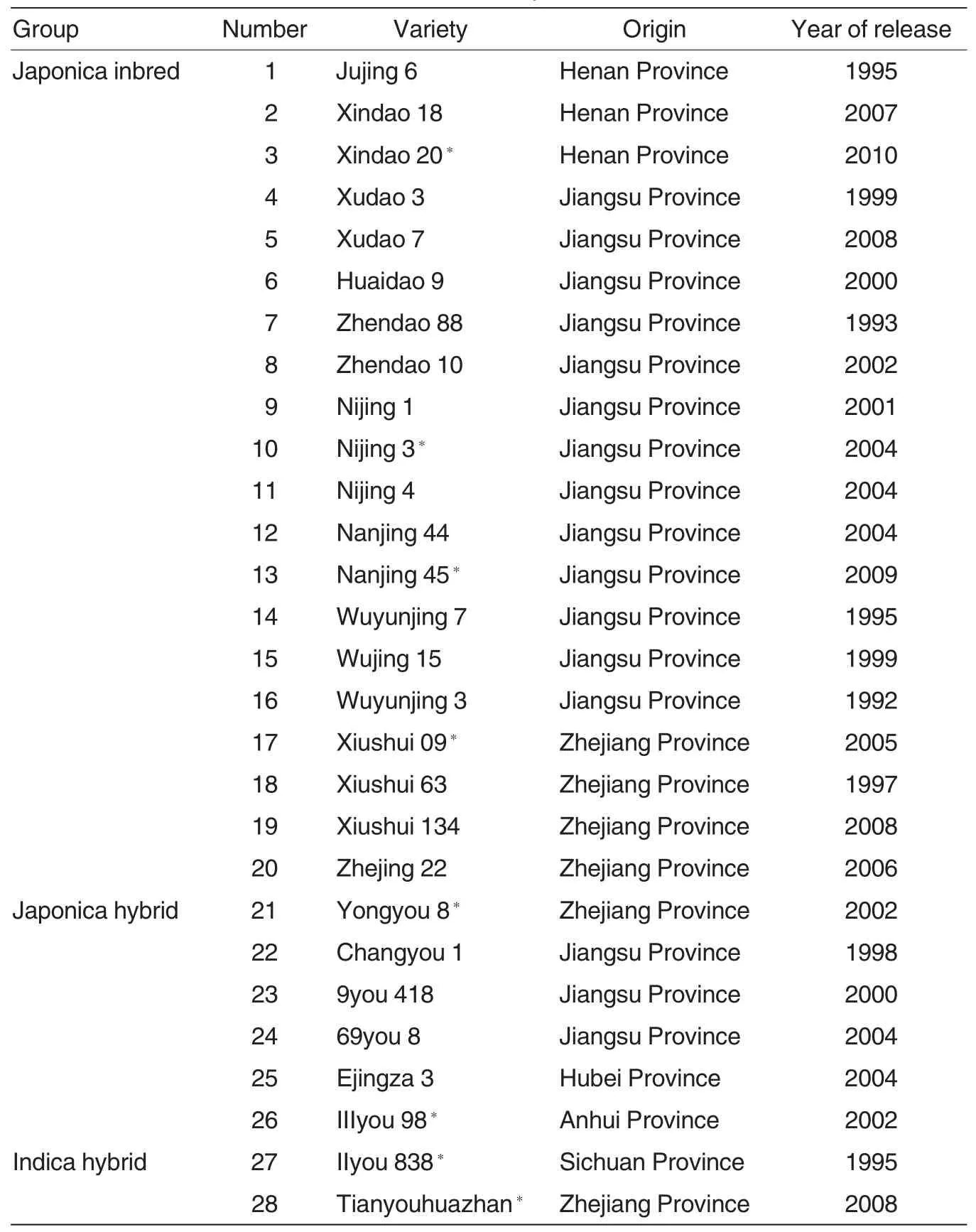
Table 1 Information about varieties used in the experiment
At maturity,5 hills with average panicle numbers (excluding those in border plants)were sampled from each plot to determine aboveground biomass,harvestindex,and yield components.Grain yield was determined from a 5 m2harvest area within each plot and adjusted to a moisture content of 14%.Rice quality was determined by the China National Rice Research Institute according to the China NationalStandard ofGrain quality Measurements(GB/T 17891-1999)issued by the Ministry of Agriculture of China[20].Brown rice percentage (BRP),milled rice percentage(MRP),andheadricepercentage(HRP)were calculated based on the rough rice weight.Chalky grain percentage(CGP)and chalkiness degree(CD)were measured using a C-300 Whiteness Tester(Kett Electric Laboratory,Tokyo,Japan).Gelatinization temperature (GT)wasmeasured based on the alkali spread value.A low alkali spread value indicates a high GT.The milled rice grainswere ground into flour with a stainless steel grinder(FW-100,China)and passed through a 100 mesh sieve for determining gel consistency(GC),amylase content(AC),and protein content(PC)according to the China National Standard for rice quality evaluation[20].
Statisticalanalyses were performed using analysisofvariance(ANOVA)(SPSS 11.5,Chicago,IL,USA).Where necessary,the data were square-root transformed to meet homogeneity of variance and normality assumptions of the ANOVAs.Means were tested using the least significant difference with a significance level of P<0.05.
Results and Analysis
Temperature
The air temperature during the rice-growing season had marked differencesbetween2011and2012(Fig.2).In June,mean,maximum,and minimum temperatures were higher in 2011 than in 2012.In July,no significant differences in temperatures were observed between 2011 and 2012.In August,mean and maximum temperatures were greater in 2011 than in 2012,but with no significant differences in the minimum temperature.In September,mean,maximum,and minimum temperatures were higher in 2011 than in 2012,whereas the opposite trends were observed in October.
Growth duration
The length of vegetative growth period (from sowing to heading)was significantly greater for indica hybrid varieties than for japonica inbred varieties in 2011,while with a marginally significant difference between indica hybrid and japonica hybrid varieties(P=0.09)(Table 2).Both reproductive(from heading to maturity)and total(from sowing to maturity)growth durations were significantly longer for indica hybrids than for japonica inbreds and japonica hybrids in 2011.Indica hybrids had significantly longer vegetative and total growth durations than japonica inbreds and japonica hybrids in 2012,but no significant differences in the length of reproductive growth period were observed among the three varietal groups(Table 3).
Yield and yield components
Indica hybrids produced higher grain yield than japonica hybrids and japonica inbreds in 2011,but with no significant differences in biomass among the three varietal groups,thus leading to a higher harvest index for indica hybrids than for japonica hybrids and japonica inbreds (Table 4).In contrast, although the yield and biomass of indica hybrids tended to be higher than those of japonica hybrids and japonica inbreds,there were no statistically significant differences in yield,biomass,and harvest index among the three varietal groups in 2012(Table 5).There were no consistent differences in panicles per m2among the three varietal groups.Japonica inbreds had higher panicles per m2than japonica hybrids but had no significant differences with indica hybrids in 2011,while no significant differences were observed among the threevarietal groups in 2012.Japonica inbreds had the lowest spikelets per panicle,but with no significant differences between japonica hybrids and indica hybrids in both 2011 and 2012.Sink size (spikelets/m2)was significantly greater for indica hybrids than for japonica hybrids and japonica inbreds in 2011,but with no significant differences among the three varietal groups in 2012.Trends in the percentage of filled grains were consistent in 2011 and 2012 as follows:japonica inbreds>japonica hybrids>indica hybrids,but no statistically significant differences were found among the three varietal groups due to large genotypic variations.There were no significant differences in grain weight among the three varietal groups in either 2011 or 2012.
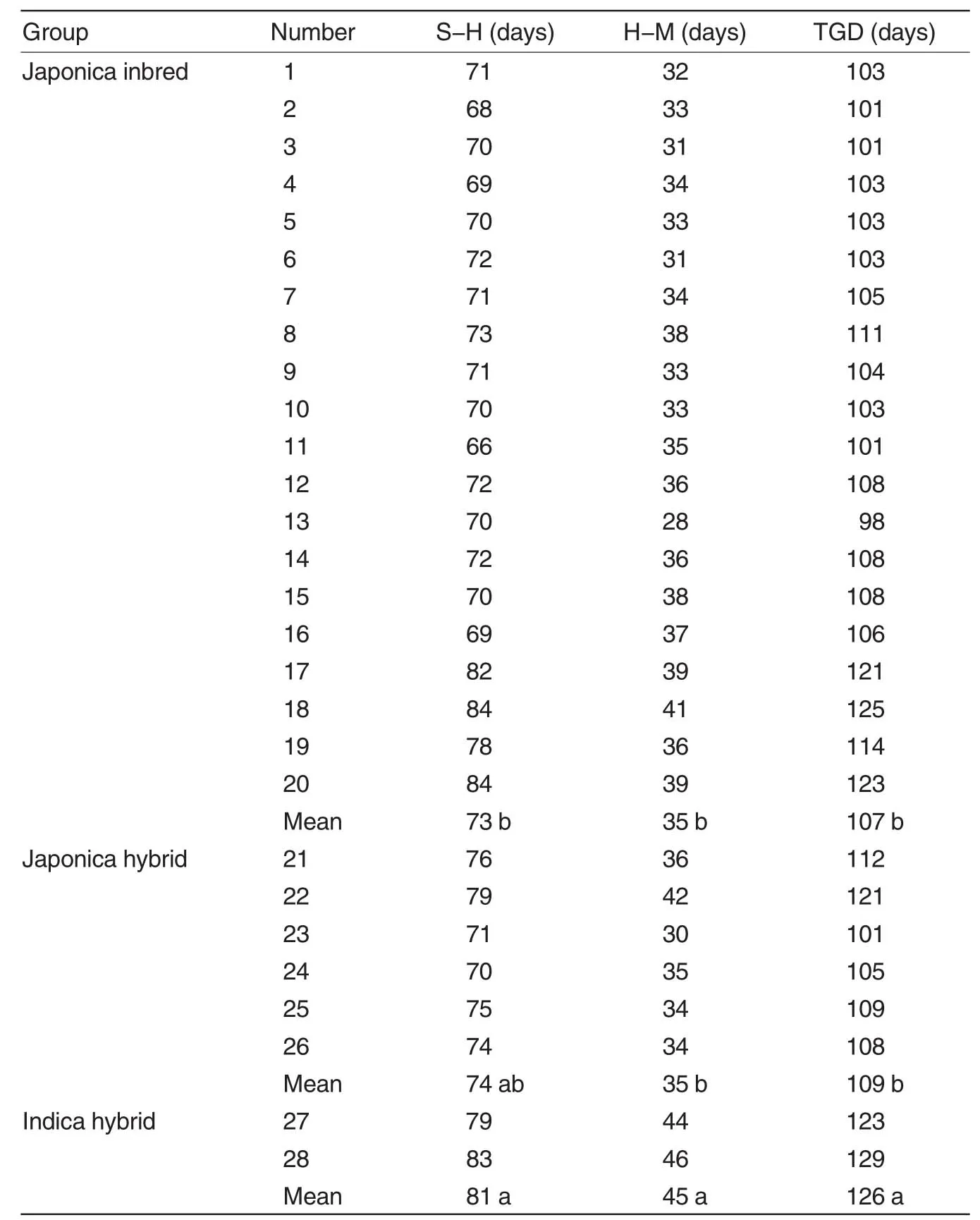
Table 2 Growth duration of different varieties grown in the late season in 2011
Indica hybrids had significantly lowerbrown rice percentage than japonica hybrids and japonica inbreds(Table 6).Milled rice percentage was significantly higher for japonica inbreds than for indica hybrids with a marginally significant difference between indica hybrid and japonica hybrid varieties(P=0.07).Head rice percentage tended to be lower for indica hybrids than for japonica hybrids and japonica inbreds with P=0.12 and 0.11,respectively.Both kernel length and length/width ratio were significantly greater for indica hybrids than for japonica hybrids and japonica inbreds.Indica hybrids had lower chalky grain percentage and chalkiness degree,but with no significant differences among the three varietal groups due to large genotypic variations. Gelatinization temperature measured based on the alkali spread value was significantly higherforindica hybrids than for japonica hybrids and japonica inbreds.Indica hybrids had significantly higher amylose content than japonica hybrids and japonica inbreds,whereas no significant differences in gel consistency and protein content were observed among the three varietalgroups.
Economic analysis
Among the three varietal groups,japonica hybrid varieties had the highest cost and the lowest net return in both 2011 and 2012(Table 7).In contrast,indica hybrids gained the highest output and the lowest cost,thus leading to the highest net return in both 2011 and 2012.The net returns were 16.1%and 9.9%greater for indica hybrids than for japonica hybrids and japonica inbreds in 2011,with only 3.8%and 1.3%in 2012,respectively.
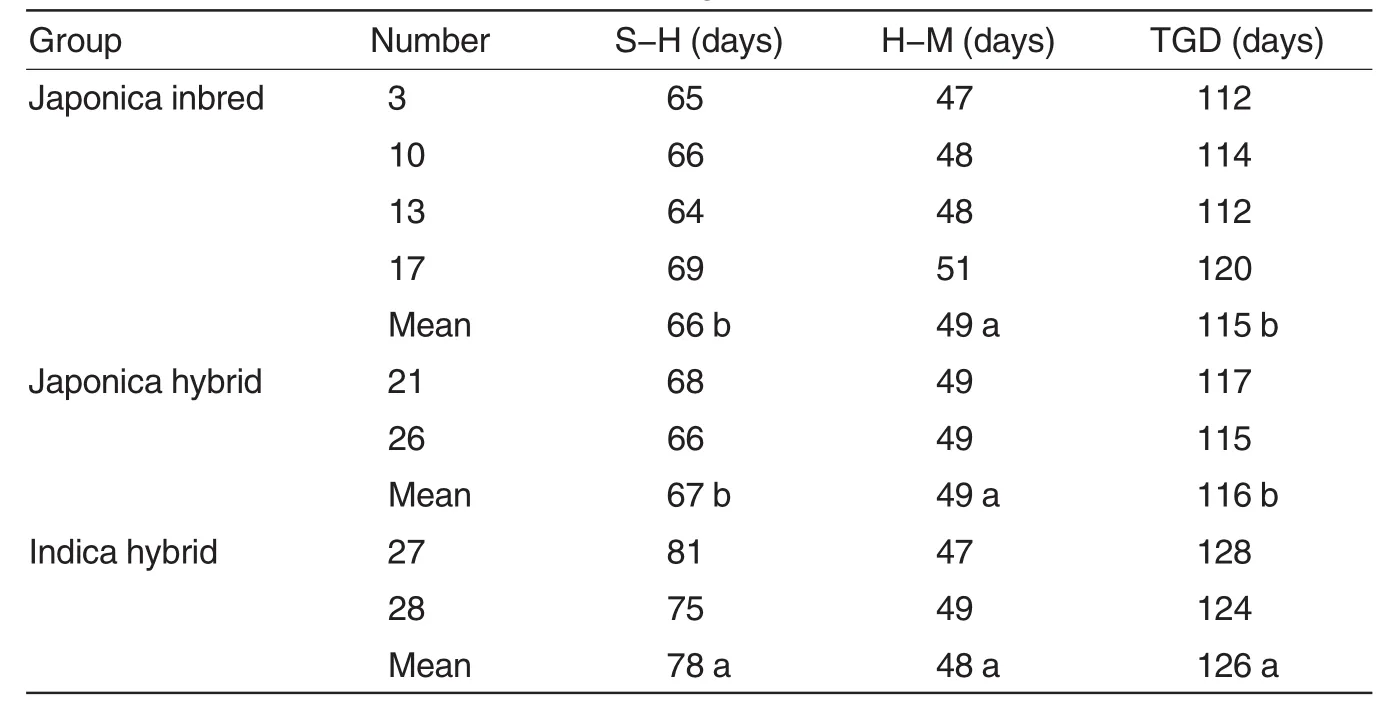
Table 3 Growth duration of different varieties grown in the late season in 2012
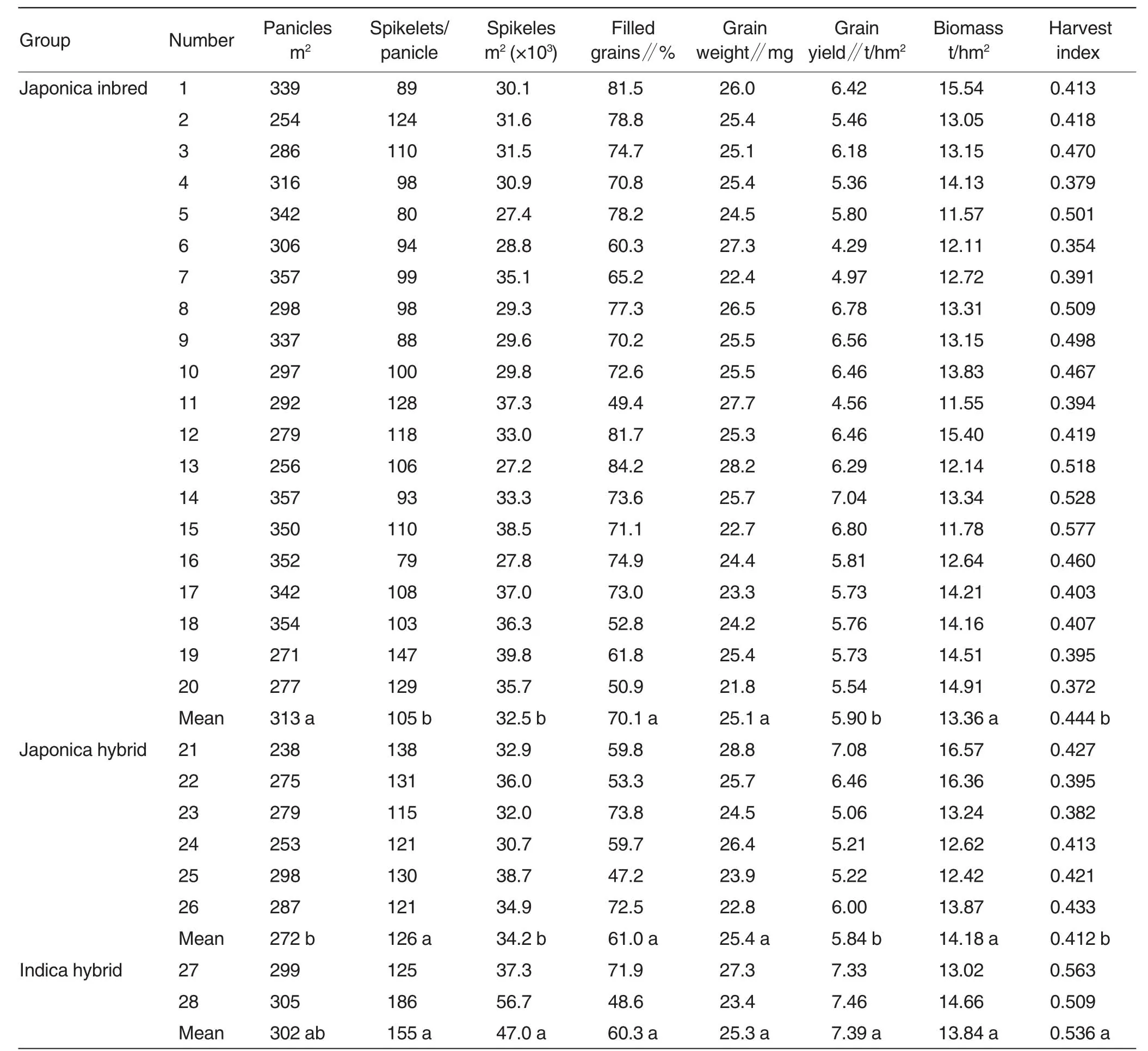
Table 4 Grain yield,yield components,biomass,and harvest index of different varieties grown in the late season in 2011
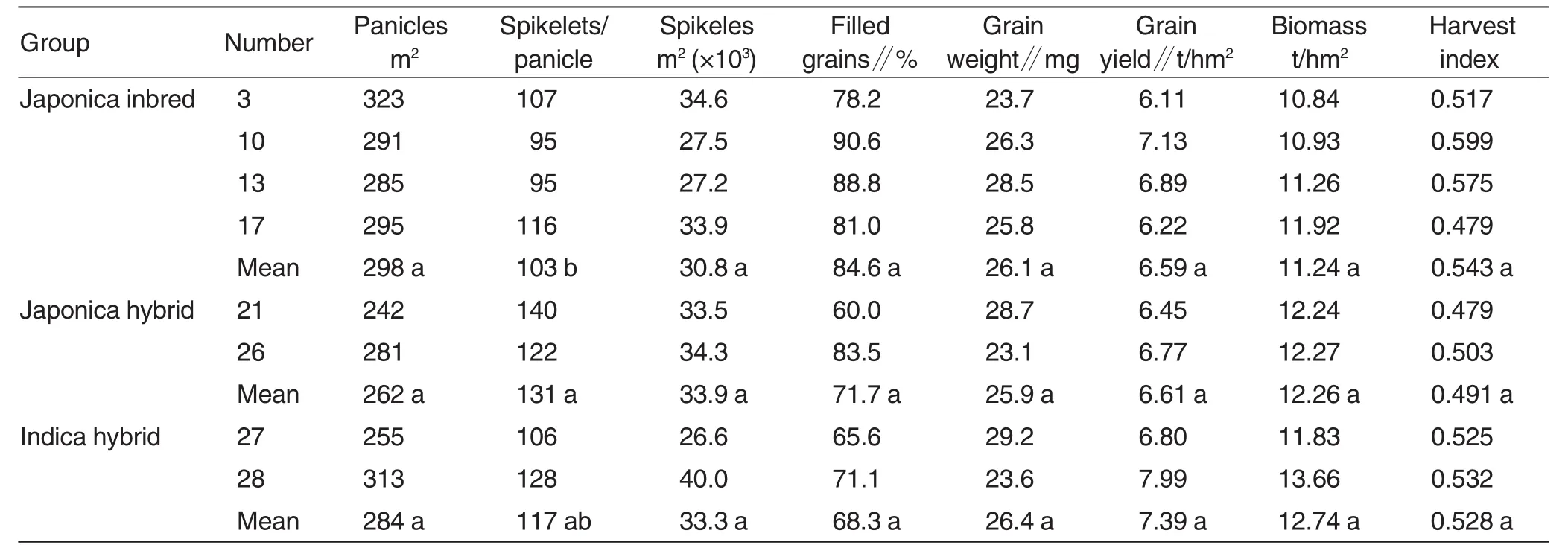
Table 5 Grain yield,yield components,biomass,and harvest index of different varieties grown in the late season in 2012
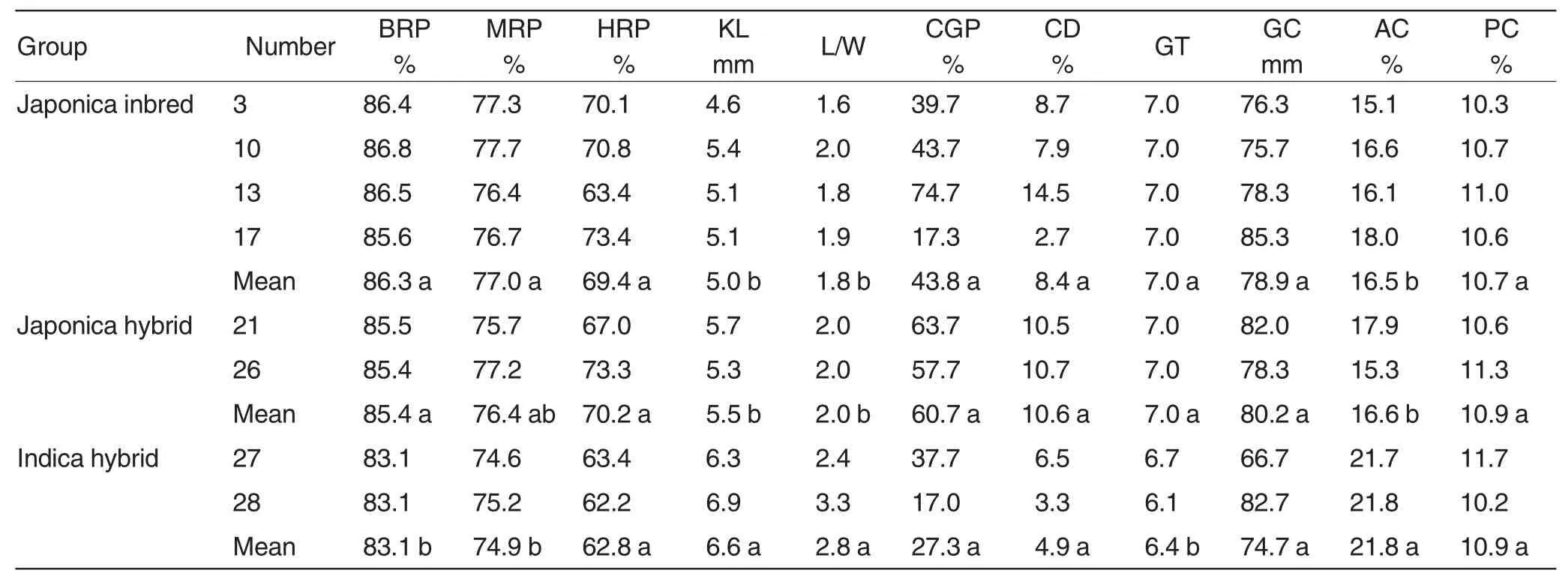
Table 6 Grain quality characteristics of different varieties grown in the late season in 2012
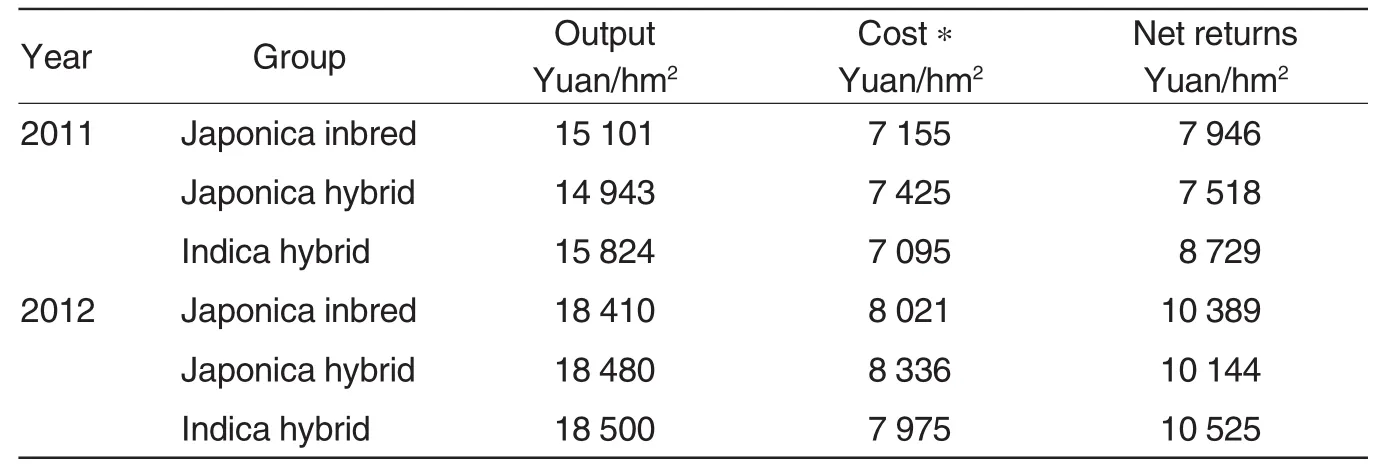
Table 7 Economics of different rice varietal groups grown in the late season in 2011 and 2012
Discussion
In contrast with Huanget al.[18],who reported that japonica hybrids grown in the late season produced higher grain yield than local elite indicas in 2009,the present results indicated that japonicas had lower yield than locally adapted indicas.In addition to differences in varieties and soil conditions[6],we speculated that the relatively cool climate may be suitable forthe growth and production of japonicas at the site in Huanget al.[18],with a 1.2℃lower in mean annual temperature than ourexperimental site.
The lower grain yield of japonica rice varieties was attributed to limitation in both source and sink.For the source,japonica rice varieties had shorter total growth duration than locally adapted indicas.In agreement with previous results[21],the present correlation analyses indicated that total growth duration was significantly and positively correlated with both grain yield and biomass in 2011,while vegetative and reproductive growth durations were only significantly positively correlated with biomass and grain yield,respectively (data not shown).Zhanget al.[22]also showed that long growth duration and thus high accumulated incident radiation were responsible for high biomass and grain production.As the contribution of postanthesis assimilate accumulation is estimated at 60%-90%of the final grain yield,depending on the cultivar and the environmental conditions,the length of reproductive period is more closely related to grain yield than that of vegetative period[21,23].Longer grainfilling duration provided rice plants with more cumulative mean temperature and cumulative solar radiation for the effective grain-filling period,and thus was a main factor that determined grain yield on unit area basis[24].Reproductive growth duration was significantly shorter for japonicas than for indicas in 2011,thus leading to lower grain yield (Tables 2,4).Moreover,japonicas had longerreproductive growth duration in 2012 than in 2011,which maypartiallyexplain higher grain yield in 2012 than in 2011.The shorter reproductive growth duration in 2011 was mainly due to the higher temperature in 2011 than in 2012,particularly inAugustand September when most varieties were at heading and grain-filling stages(Fig.2).A large body of research has demonstrated that high temperature could accelerate crop development and shorten growth duration[25-27].On the other hand,in spite of the shorter total growth duration for japonicas than for indicas in both 2011 and 2012,no significant differences in aboveground biomass were observed(Tables 4,5).This suggests that the growth rate of japonicas may be greater than indicas,which could compensate to some extent for the reduction in carbon stabilization resulting from the shortened growth duration[28].For the sink,sink size(spikelets/m2)was significantly smaller for japonicas than for indicas in 2011,thus limiting the production and remobilization of assimilates into grains[23].In addition,the lower percentage of filled grains in 2011 than in 2012,irrespectively ofvarietalgroups,also showed that 2011 was hotter than 2012,as high temperature could cause spikelet sterility in rice[29].Furthermore,high temperature may reduce sink activity owing to the earlier senescence ofpanicle,thereby resulting in an early termination of grain filling[25].
The argument that growing japonica varieties could alleviate the cold stress imposed on indicas during the heading stage due to their high cold tolerance was not verified in the present study[5].On the one hand,no cold stress occurred during the experimental period.On the other hand,high temperature,particularly atpanicle initiation and heading at the present site,may cause heat stress such as that in 2011.Japonica rice varieties thatadaptedto temperateclimate may have lower heat tolerance than indicas[12-13].Moreover,temperaturemay be already above the optimum for rice growth at the experimental site[30].Climate warming is expected to increase the frequency and intensity of extreme high-temperature events[31].Historical data have indicated that low-temperature stress at the heading-flowering stage of late rice in double rice regions has reduced,whereas high-temperature stress has increased over the last decades[14-15].Thus,replacing indicas with japonica varieties as late rice cropping is likely to enhance the risk of yield loss owing to heat stress in the study region.
Higher brown rice,milled rice,and head rice percentages in japonicas than in indicas could increase their market value and the income of both rice producers and processors.The better processing qualities in japonicas may be associated with the lower kernel length and length/width ratio than in indicas[32].However,japonicas grown in the study region had higher chalky grains and chalkiness than indicas,which reduced their acceptance by consumers and market value[33].As discussed above,hotter climate and lower high-temperature tolerance in japonicas than in indicas deteriorated the appearance qualities because high temperature during the grain development facilitated the formation of chalky grains through the loose packing of amyloplasts[34-35].It should be noted that there were large genotypic variations in appearance qualities.For instance,Xiushui 09 had the lowest chalky grain percentage and chalkiness degree among various japonica varieties,suggesting an opportunity for breeders to screen for locally adapted japonicas with high heat tolerance and grain quality.Higher gelatinization temperature(i.e.,lower alkali spreading value)in indicas than in japonicas required more time to cook,and the cooked rice had an unacceptable texture,thus reducing the cooking quality of rice[33].In addition,lower amylose content in japonicas than in indicas contributed to the greater eating quality of rice because varieties with low or intermediate amylose content cook dry and fluffy and could retain soft texture even after cooling,which are most favored by consumers in China[35-36].Last but not least,indica hybrids had higher net returns due to their greater grain yield and lower fertilizer cost than japonicas.Therefore,another argument that replacing current indicas with japonica varieties could increase the profitability of rice production was not supported by the present study either.It should be noted that the present fertilization rates of japonicas were set according to the yield level in their original regions.Thus,there is room to reduce the fertilizer rates and cost of japonicas due to their relatively low productivity at the present site[5-6].
Conclusions
Japonica rice varieties grown in the late season produced lower grain yield than local elite indicas,particularly in 2011 due to high temperature.Japonica rice varieties had better processing(higher brown rice,milled rice,and head rice percentages)and eating/cooking qualities(lower gelatinization temperature and amylose content)compared with indicas,but showed a worse appearance quality (higher chalky grain percentage and chalkiness degree).Japonica rice varieties gained lower net returns than indicas.Given the declining trend in cold stress and increasing frequency and intensity of high temperature under climate warming,replacing indicas with japonica varieties as late rice may increase the risk of heat stress in the double rice cropping region.Therefore,specific japonica rice varieties should be developed to adapt local conditions;otherwise,replacing indicas with current japonica varieties as late rice may not be feasible at the present site.
[1]FAOSTAT.Http://faostat.fao.org/default.aspx?lang=en[E].
[2]PENG S,TANG Q,ZOU Y.Current status and challenges of rice production in China[J].Plant Prod Sci,2009,12:3-8.
[3]VEECK G.China’s food security:Past success and future challenges[J].Eurasian Geogr Econ,2013,54:42-56.
[4]CHEN W,PAN W,XU Z.Current situation and trends in production of japonica rice in China[J].J Shenyang Agric Univ,2006,37:801-805.
[5]CHENG F,ZHOU P.Strategies for promoting the production of japonica rice in Jiangxi Province[J].China Agric Technol Ext,2012,28:7-9.
[6]ZHANG H,XU K,ZHANG J,et al.Productivity and eco-physiological characteristics of late japonica rice in doublecropping rice system[J].Acta Agron Sin,2014,40:283-300.
[7]XIE H,JING Y,ZENG Q,et al.The necessity and tendency of developing japonica hybrid rice in China[J].North Rice,2007,3:10-13.
[8]NationalDevelopmentandReform Commission (NDRC),People’s Republic of China.Http://www.ndrc.gov.cn/xwzx/xwfb/201402/t20140211_578631.html[E].
[9]VAN DEN BERG MM,HENGSDIJK H,WOLF J,et al.The impact of increasing farm size and mechanization on rural income and rice production in Zhejiang province,China[J].Agric Syst,2007,94;841-850.
[10]CHEN F,PANDEY S,DING S.Changing rice cropping patterns:Evidence from the Yangtze River Valley,China[J].Outlook Agric,2013,42:109-115.
[11]YU Y,HUANG Y,ZHANG W.Changes in rice yields in China since 1980 associated with cultivar improvement,climate and crop management[J].Field Crops Res,2012,136:65-75.
[12]FAGERIA NK.Yield physiology of rice[J].J Plant Nutr,2007,30:843-879.
[13]KHUSH GS.Origin,dispersal,cultivation and variation of rice[J].Plant Mol Biol,1997,35:25-34.
[14]SUN W,HUANG Y.Global warming over the period 1961-2008 did not increase high-temperature stress but did reduce low-temperature stress in irrigated rice across China[J].Agric For Meteorol,2011,151:1193-1201.
[15]TAO F,ZHANG S,ZHANG Z.Changes in rice disasters across China in recent decades and the meteorological and agronomic causes[J].Reg Environ Change,2013,13:743-759.
[16]LIU W,ZHANG X,JIAN H.Evolution trend of cold-dew wind in recent 50 years in Jiangxi Province and its influence on late double-harvest rice[J].Meteorol Disaster Reduct Res,2009,32:67-71.
[17]DENG H,ZHANG W,YANG F,et al.A preliminary study on northeastern early japonica hybrid rice planted as early rice in the double-cropping system in the middle reaches of the Yangtze River[J].Hybrid Rice,2008,23:45-47.
[18]HUANG D,CAO K,CHEN F,et al.High-yielding cultivation techniques for single japonica rice grown as late rice[J].China Rice,2010,16:40-42.
[19]IUSS Working Group WRB,World Reference Base for Soil Resources 2006,World Soil Resources Reports No.103[R].FAO,Rome,2007.
[20]Ministry of Agriculture of China(MOA),Supervising Department of Quality and Technology of China,The National Standard of the People’s Republic of China-GB/T 17891-1999:High Quality Rice[M].China Standard Press,Beijing,2000.
[21]EGLI DB.Time and the productivity of agronomic crops and cropping systems[J].Agron J,2011,103:743-750.
[22]ZHANG Y,TANG Q,ZOU Y,et al.Yield potential and radiation use efficiency of"super"hybrid rice grown under subtropical conditions[J].Field Crops Res,2009,114:91-98.
[23]YANG J,ZHANG J.Crop management techniques to enhance harvest index in rice[J].J Exp Bot,2010,61:3177-3189.
[24]YANG W,PENG S,DIONISIO-SESE ML,et al.Grain filling duration,a crucial determinant of genotypic variation of grain yield in field-grown tropical irrigated rice[J].Field Crops Res,2008,105:221-227.
[25]KIM J,SHON J,LEE C,et al.Relationship between grain filling duration and leaf senescence of temperate rice under high temperature[J].Field Crops Res,2011,122:207-213.
[26]LIU L,WANG E,ZHU Y,et al.Contrasting effects of warming and autonomous breeding on single-rice productivity in China [J].Agric Ecosyst Environ,2012,149:20-29.
[27]ZHANG T,HUANG Y,YANG X.Climate warming over the past three decades has shortened rice growth duration in China and cultivar shifts have further accelerated the process for late rice[J].Global Change Biol,2013,19:563-570.
[28]XUE Y,DUAN H,LIU L,et al.An improved crop management increases grain yield and nitrogen and water use efficiency in rice[J].Crop Sci,2013,53:271-284.
[29]JULIA C,DINGKUHN M.Predicting temperature induced sterility of rice spikelets requires simulation of cropgeneratedmicroclimate[J].EurJ Agron,2013,49:50-60.
[30]KRISHNAN P,RAMAKRISHNAN B,RAJA REDDY K,et al.High-temperature effects on rice growth,yield,and grain quality[J].Adv Agron,2011,111:87-206.
[31]WASSMANN R,JAGADISH SVK,SUMFLETH K,et al.Regional vulnerability of climate change impacts on Asian rice production and scope for adaptation[J].Adv Agron,2009,102:91-133.
[32]WANG Q,HUANG J,HE F,et al.Head rice yield of “super” hybrid rice Liangyoupeijiu grown under different nitrogen rates [J].Field Crops Res,2012,134:71-79.
[33]FITZGERALD MA,MCCOUCH SR,HALL RD.Not just a grain of rice:The quest for quality[J].Trends Plant Sci,2008,14:133-139.
[34]ISHIMARU T,HORIGANE AK,IDA M,et al.Formation of grain chalkiness and changes in water distribution in developing rice caryopses grown under high-temperature stress[J].J Cereal Sci,2009,50:166-174.
[35]WANG Y,FREI M.Stressed food-The impact of abiotic environmental stresses on crop quality[J].Agric Ecosyst Environ,2011,141:271-286.
[36]YANG L,WANG Y,DONG G,et al.The impact of free-air CO2enrichment(FACE)and nitrogen supply on grain quality of rice [J].Field Crops Res,2007,102:128-140.
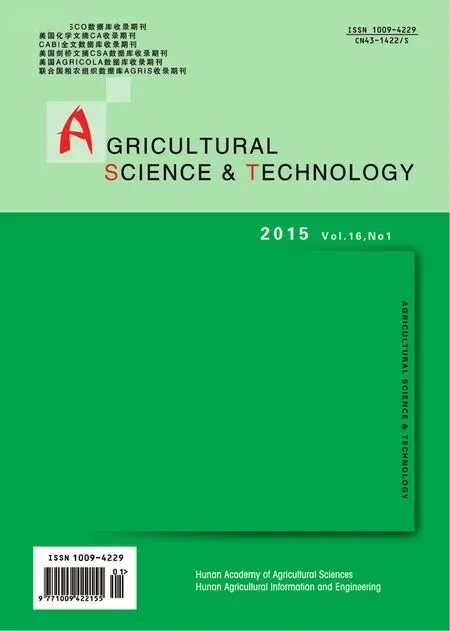 Agricultural Science & Technology2015年1期
Agricultural Science & Technology2015年1期
- Agricultural Science & Technology的其它文章
- Effects of Nutrient Solution pH on the Growth of Seedlings of Sugarcane
- Effects of Soaking Seeds with Different Solutions on the Growth and Yield of Rice
- Effects of Traditional Chinese Herbal Medicine on the Structure of Duodenal Mucosa of Chickens under Heat Stress
- The Breeding and Application of a New Super High-yield Mini Watermelon Variety‘Jinmi 2’
- Optimization of Microwave Extraction of Flavonoids from Water Chestnut Skin Dregs with Response Surface Method
- Establishmentand Comparison of Two TaqMan Real-time PCR Methods for PCV2
